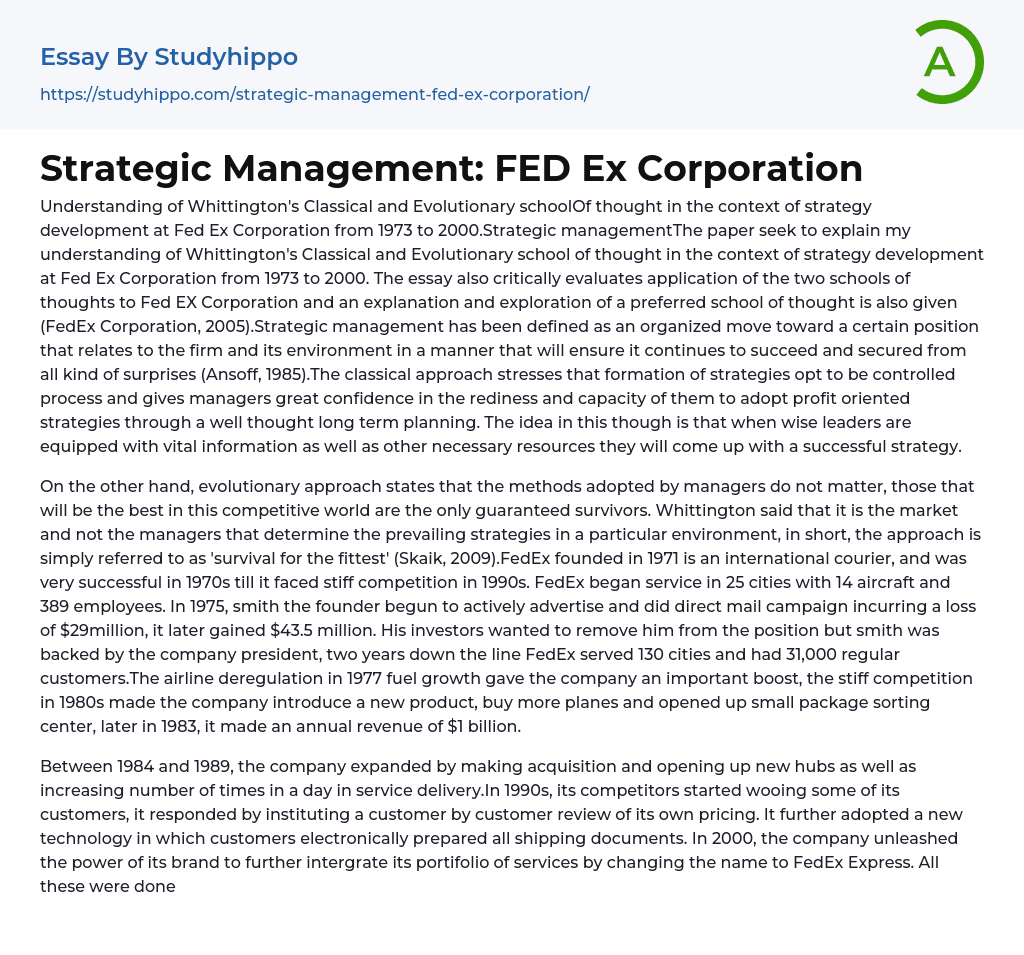The aim of this paper is to analyze Whittington's Classical and Evolutionary school of thought in relation to strategy development at Fed Ex Corporation between 1973 and 2000. The essay also assesses the application of both schools of thought at Fed Ex Corporation and provides an explanation and exploration of a preferred school of thought (FedEx Corporation, 2005). Strategic management is defined as the organized approach taken by a firm to position itself in relation to its environment, ensuring continued success and protection against unexpected events (Ansoff, 1985). The classical approach emphasizes the need for strategy formation to be a controlled process, giving managers confidence in their ability to develop profit-oriented strategies through long-term planning. It suggests that wise leaders, equipped with necessary information and resources, will create successful strategies.
According to the evolutionary approach, managers' methods a
...re irrelevant and only strategies that prove successful in a competitive world will thrive. Whittington argues that prevailing strategies are determined by the market, not managers, which is commonly known as 'survival of the fittest' (Skaik, 2009).
Established in 1971, FedEx is an international courier service that achieved great success during the 1970s but faced intense competition in the 1990s. Initially serving 25 cities with 389 employees and operating 14 aircraft, founder Smith launched an advertising and direct mail campaign resulting in a $29 million loss. However, this loss was later offset by a gain of $43.5 million. Despite investor pushback against Smith's leadership, he received support from the company president. Two years later, FedEx expanded to serve 130 cities and gained 31,000 regular customers.
The airline deregulation in led to significant growth for FedEx. In response to increase
competition in the , they introduced new products, expanded their plane fleet, and established small package sorting centers. By , their annual revenue reached $1 billion.
From 1984 to 1989, the company underwent expansion through acquisitions, opening new hubs, and increasing service delivery frequency. However, in the 1990s, its competitors began to attract some of its customers, prompting the company to conduct individual pricing reviews for each customer. Additionally, a new technology was implemented that allowed customers to electronically prepare shipping documents. In 2000, the company utilized its brand power to integrate its services by changing its name to FedEx Express.
All these efforts were aimed at helping the company survive in a competitive market, despite facing numerous challenges. Both the Classical and Evolutionary strategies proposed by Whittington were considered for strategic management. In the case of FED Ex Corporation, I recommend adopting the Classical approach, which involves deliberate calculations and analysis to maximize the organization's operations and advantages.
FED Ex Corporation encounters a range of challenges in the domains of politics, society, economics, and technology. In order to stay ahead in the competition, it is imperative for the organization to examine how political factors such as market legislation, controls, and regulations affect its operations. Ansoff (1985) recommends considering the impact of economic trends on business. Therefore, FED Ex should take into account how economic trends in different regions can influence its short-term and long-term operations. It is also vital to consider the social aspects of diverse cultures and business communities that are served by the company so as to develop operations accordingly and strategize for meeting evolving client needs. Marketing plays a crucial role in
ensuring the sustainability of the company. Consequently, analyzing product, price, place, and promotion strategies with a classical approach is indispensable for FED Ex. Continuous improvement and value-added services are essential for maintaining an advantage over competitors.
Marketing places play a crucial role as they enable the company to attract new market segments. Through price analysis, the company can guarantee competitive pricing for its goods and services, ultimately capturing a larger market share while retaining its customer base. Furthermore, consistent and selective promotion of offerings is vital in effectively reaching the desired target market.
- Chief Executive Officer essays
- Convenience Store essays
- Firm essays
- Training And Development essays
- Unilever essays
- Variable Cost essays
- Virgin Group essays
- Bargaining essays
- Entity essays
- Pest analysis essays
- Leadership and Management essays
- Change Management essays
- Project Management essays
- Knowledge Management essays
- Operations Management essays
- Quality Management essays
- Risk Management essays
- Scientific Management essays
- supply chain management essays
- Performance Management essays
- Time Management essays
- Brand Management essays
- Total Quality Management essays
- Risk essays
- Manager essays
- Leadership essays
- Business Ethics essays
- Board Of Directors essays
- Product Management essays
- Comparative Analysis essays
- Decision Making essays
- Dispute Resolution essays
- Stress Management essays
- Business Management essays
- Brand Equity essays
- Branding essays
- Nike, Inc. essays
- Market share essays
- Razor essays
- Being A Leader essays
- Servant Leadership essays
- Leadership Experience essays
- Leadership Qualities essays
- Incentive essays
- John Locke essays
- 9/11 essays
- A Good Teacher essays
- A Healthy Diet essays
- A Modest Proposal essays
- A&P essays




